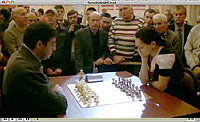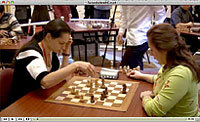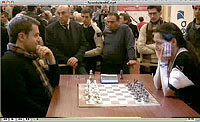U.S. Chess Championships 2014 R3: Lenderman Leads; Krush, Zatonskih Tied Atop Women's Section
Hello Chess Blog friends, are you following the U.S. Chess Championships 2014 live? Catch all the action live at www.uschesschamps.com/live. Meanwhile, here is the Round 3 update by Brian Jerauld:
SAINT LOUIS (May 11, 2014) -- Full-point victories: A dime a dozen for the ladies; but hard to come by for the men.
After ten draws and only two wins since the tournament’s start, the U.S. Championship saw just two more wins in Saturday’s third round. Aleksandr Lenderman’s second victory of the competition set him alone out front with 2.5/3, and Timur Gareev trails with 2/3 after adding a win over Daniel Naroditsky to a pair of draws.
On the other hand, No one in the U.S. Women’s Championship shows interest in chopping points, with Saturday showcasing another four wins out of five games - though the standings have taken a familiar shape. Irina Krush and Anna Zatonskih, who have split the women’s national title four times each over the last eight years, are tied atop with 2.5/3.
Trailing just a half-point behind the perennials, however, is 13-year-old Ashritha Eswaran, who earned her second point in three rounds in her first-ever appearance in the national championship. The California native turned in her second marathon-endgame dazzler of the tournament on Saturday, this time over Camilla Baginskaite as the women’s tournament heads into a rest day on Mother’s Day.
In the U.S. Championship on Sunday, Lenderman will take the white pieces against Ray Robson, also with 2/3 and tied with Gareev for second place.
Lenderman has led since round one, though not without a bit of luck on his side: Despite being in clear losing positions in both of his first two matches, Lenderman took advantage of two 11th-hour lapses by his opponents to score 1.5 points. His game against Alejandro Ramirez on Saturday, however, was a bit more traditional in the art of winning.
One would think Ramirez is well-booked in the French defense after using it to hold a draw against Gata Kamsky in round 2, but Lenderman came prepped with a shocking line out of the Tarrasch that featured a voluntarily 14...Kf8 before castling. Even more surprising was his follow-up h6-h5 and 16...Ng4 that began Ramirez’ suffering for the rest of the game. His clock was below 15 minutes by move 20.
Ramirez endured the agony for 62 moves, however, clinging to an endgame down an exchange with four scattered pawns before resigning.
In an extreme reversal of roles, it was the 13-year-old Eswaran who proved to have ice in her veins and, instead, the veteran who fumbled in time pressure. Camilla Baginskaite made an illegal move in her 62nd play, touching her queen while her king was in check and ultimately surrendering the point.
Baginskaite had found early equalization and was even enjoying a lead after her knight found a solid outpost at 14...Nxc5. Then, her follow-up 15...Bg5 forced a trade of the dark-squared bishops and left her knight as the superior minor piece.
But she reacted poorly to Eswaran’s 29. g4, first giving back her advantage with 29...Rc7, which allowed the g-file to open in front of her king, then losing with 31...Rf8. Black dropped a pawn with 26...Qxe4.
Eswaran started pecking away at the queen-and-pawns endgame, but had trouble corralling black’s king - ultimately chasing it back into better position and allowing equalization again at 49...Qg3+. The game appeared to be headed toward a dead draw, despite two pawns promoting on the 57th move to feature four queens on an open board.
But under time pressure, Baginskaite failed to protect her king and instead touched a queen. When the arbiter came to add penalty minutes to Eswaran’s clock, Baginskaite took the moment to simply resign from her long-suffering position.
Zatonskih got a slow start in this year’s tournament when Iryna Zenyuk earned her first half-point ever in seven games against the four-time champion in the first round. But she has caught pace since then with two straight wins, the latest on Saturday over Sabina Foisor, who entered the day with a perfect 2/2 score.
Zatonskih defended against Foisor in the Nimzo-Indian at a slow and methodical pace, chewing up an hour of her clock before her tenth move. By move 13, Zatonskih had just 17 minutes left - though she also had found quick equalization, and eventually a healthy lead.
12. e4 did not work, only setting up a series of captures that left Zatonskih up two pawns. Foisor’s 18. Bxd7 only helped black toward simplification and, despite the time trouble, Zatonskih coasted through an easy endgame.
“My position was very easy - I don’t mean like easy to win, but easy to find moves to play,” Zatonskih said. “It was concrete lines and with a 30 second increment in such a position, it should be enough. I think white needs time in such a position to prove she had compensation for the pawn. For black, it was pretty particular what black was supposed to do.”
Naroditsky, the reigning U.S. Junior Closed Champion, never seemed to get his King’s Indian Defense up and running properly, as Gareev turned an early lead into a slow squeeze by the fundamentals. Already advanced on d5, Gareev pushed 18. e5 as well as 19. f5 to further clog Naroditsky’s already cramped position.
19...f6 rendered the black bishop useless for the rest of the game, and Gareev simply rolled downhill through the endgame.
From Alexandra Kosteniuk's
SAINT LOUIS (May 11, 2014) -- Full-point victories: A dime a dozen for the ladies; but hard to come by for the men.
After ten draws and only two wins since the tournament’s start, the U.S. Championship saw just two more wins in Saturday’s third round. Aleksandr Lenderman’s second victory of the competition set him alone out front with 2.5/3, and Timur Gareev trails with 2/3 after adding a win over Daniel Naroditsky to a pair of draws.
On the other hand, No one in the U.S. Women’s Championship shows interest in chopping points, with Saturday showcasing another four wins out of five games - though the standings have taken a familiar shape. Irina Krush and Anna Zatonskih, who have split the women’s national title four times each over the last eight years, are tied atop with 2.5/3.
Trailing just a half-point behind the perennials, however, is 13-year-old Ashritha Eswaran, who earned her second point in three rounds in her first-ever appearance in the national championship. The California native turned in her second marathon-endgame dazzler of the tournament on Saturday, this time over Camilla Baginskaite as the women’s tournament heads into a rest day on Mother’s Day.
In the U.S. Championship on Sunday, Lenderman will take the white pieces against Ray Robson, also with 2/3 and tied with Gareev for second place.
Lenderman has led since round one, though not without a bit of luck on his side: Despite being in clear losing positions in both of his first two matches, Lenderman took advantage of two 11th-hour lapses by his opponents to score 1.5 points. His game against Alejandro Ramirez on Saturday, however, was a bit more traditional in the art of winning.
One would think Ramirez is well-booked in the French defense after using it to hold a draw against Gata Kamsky in round 2, but Lenderman came prepped with a shocking line out of the Tarrasch that featured a voluntarily 14...Kf8 before castling. Even more surprising was his follow-up h6-h5 and 16...Ng4 that began Ramirez’ suffering for the rest of the game. His clock was below 15 minutes by move 20.
Ramirez endured the agony for 62 moves, however, clinging to an endgame down an exchange with four scattered pawns before resigning.
“Part of it was prep, but then I didn’t remember all of it, and I was figuring it out at the board,” Lenderman said. “Kf8 I knew. With h5, I was debating if I should play b5 first or stuff like that. I knew h5 was the idea for sure after Ng3, but I couldn’t remember if I played it at the right time; it looks like I did.”
In an extreme reversal of roles, it was the 13-year-old Eswaran who proved to have ice in her veins and, instead, the veteran who fumbled in time pressure. Camilla Baginskaite made an illegal move in her 62nd play, touching her queen while her king was in check and ultimately surrendering the point.
Baginskaite had found early equalization and was even enjoying a lead after her knight found a solid outpost at 14...Nxc5. Then, her follow-up 15...Bg5 forced a trade of the dark-squared bishops and left her knight as the superior minor piece.
But she reacted poorly to Eswaran’s 29. g4, first giving back her advantage with 29...Rc7, which allowed the g-file to open in front of her king, then losing with 31...Rf8. Black dropped a pawn with 26...Qxe4.
Eswaran started pecking away at the queen-and-pawns endgame, but had trouble corralling black’s king - ultimately chasing it back into better position and allowing equalization again at 49...Qg3+. The game appeared to be headed toward a dead draw, despite two pawns promoting on the 57th move to feature four queens on an open board.
But under time pressure, Baginskaite failed to protect her king and instead touched a queen. When the arbiter came to add penalty minutes to Eswaran’s clock, Baginskaite took the moment to simply resign from her long-suffering position.
Zatonskih got a slow start in this year’s tournament when Iryna Zenyuk earned her first half-point ever in seven games against the four-time champion in the first round. But she has caught pace since then with two straight wins, the latest on Saturday over Sabina Foisor, who entered the day with a perfect 2/2 score.
Zatonskih defended against Foisor in the Nimzo-Indian at a slow and methodical pace, chewing up an hour of her clock before her tenth move. By move 13, Zatonskih had just 17 minutes left - though she also had found quick equalization, and eventually a healthy lead.
12. e4 did not work, only setting up a series of captures that left Zatonskih up two pawns. Foisor’s 18. Bxd7 only helped black toward simplification and, despite the time trouble, Zatonskih coasted through an easy endgame.
“My position was very easy - I don’t mean like easy to win, but easy to find moves to play,” Zatonskih said. “It was concrete lines and with a 30 second increment in such a position, it should be enough. I think white needs time in such a position to prove she had compensation for the pawn. For black, it was pretty particular what black was supposed to do.”
Naroditsky, the reigning U.S. Junior Closed Champion, never seemed to get his King’s Indian Defense up and running properly, as Gareev turned an early lead into a slow squeeze by the fundamentals. Already advanced on d5, Gareev pushed 18. e5 as well as 19. f5 to further clog Naroditsky’s already cramped position.
19...f6 rendered the black bishop useless for the rest of the game, and Gareev simply rolled downhill through the endgame.
“Positionally, my situation was looking really good,” Gareev said. “His bishop was stuck, I had more space, my structure was better, my pawns were placed on better colors, my pieces were more active … I was just trying to reduce the uncertainty at that point, and for awhile Daniel was trying to push forward and complicate things. Eventually he just ran out of resources, and we got to the endgame, which was a big advantage for me.”
From Alexandra Kosteniuk's
www.chessblog.com
Also see her personal chess blog
at www.chessqueen.com
Don't miss Chess Queen™
YouTube Channel
Also see her personal chess blog
at www.chessqueen.com
Don't miss Chess Queen™
YouTube Channel
Labels: us chess championships 2014




































0 Comments:
Post a Comment
Note: Only a member of this blog may post a comment.
Subscribe to Post Comments [Atom]
<< Home